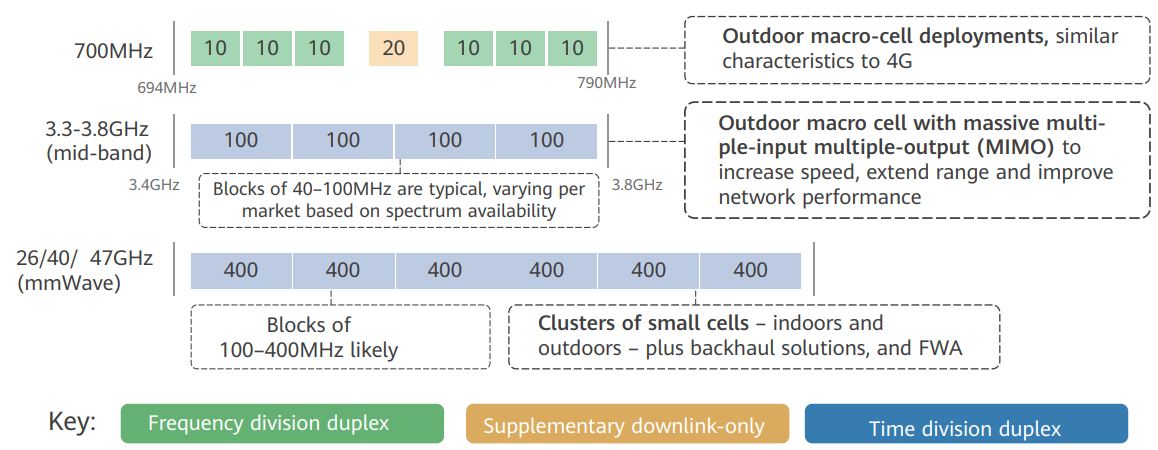The ITU-R IMT-2020 (5G) Vision includes three usage scenarios: eMBB, mMTC, and uRLLC. It also specifies the key capabilities of IMT-2020 which represent great improvements in comparison with the previous generation of IMT systems.

To address diversified requirements from the envisioned usage scenarios in different phases of 5G, 5G needs access to “high”, “mid” and “low” frequency bands, exploiting specific characteristics of different portions of the spectrum: frequencies between 2 and 8 GHz (e.g., 3300-4200, 4400-5000, 2500-2690, 2300-2400, and 5925-7125 MHz) in combination with frequencies below 2 GHz (e.g. 700 MHz) and above 8 GHz (e.g. 24.25-29.5 and 37-43.5 GHz).
A sufficient amount of harmonized spectrum in each layer should be made available by national regulators in a timely manner to enable mobile operators to deliver 5G services. The assignment of contiguous wide spectrum bandwidth in each layer reduces
system complexity associated with carrier aggregation, which will improve energy efficiency and reduce network cost.

Mid-bands between 2 to 8 GHz are crucial to support most 5G usage scenarios in wide-areas. The unpaired (TDD) bands at 3300-4200, 4400-5000, 2500-2690, and 2300-2400 MHz deliver the best compromise between wide-area coverage and high capacity.
Taking into consideration that eMBB services are dominant in the initial phase of 5G, it is highly recommended to release the mid-bands at first. In this respect, at least 80-100 MHz of contiguous spectrum bandwidth from such mid-bands should
be secured as the first step for each 5G network operator in the 5G multi-layer spectrum assignment process.
Low-frequency bands (below 2 GHz) will extend the 5G mobile broadband experience to wider areas and deeper indoor environments. Moreover, uRLLC and mMTC type services will also greatly benefit from superior coverage at the low-frequency bands.
The available low-frequency bands (e.g. 700, 800, 900, 1800, and 2100 MHz) may be exploited for LTE/NR uplink spectrum sharing in combination with NR in the 3300-3800 MHz band to allow operators to ensure faster and cost-effective deployment.
High-frequency bands (above 24 GHz) will prove indispensable for providing additional capacity and delivering the extremely high data rates required by some 5G eMBB applications at specific locations (“hotspots”).
At least 400-800 MHz of contiguous spectrum per network operator is recommended from higher frequencies to achieve good return on investment and meet service requirements.

The low and high-frequency bands layers can be released as the second step to meet different usage the requirement in the later phases of 5G development, e.g. the requirements for better coverage, lower latency or higher capacity.
Sources:
- Huawei.
- Analysis Mason.
